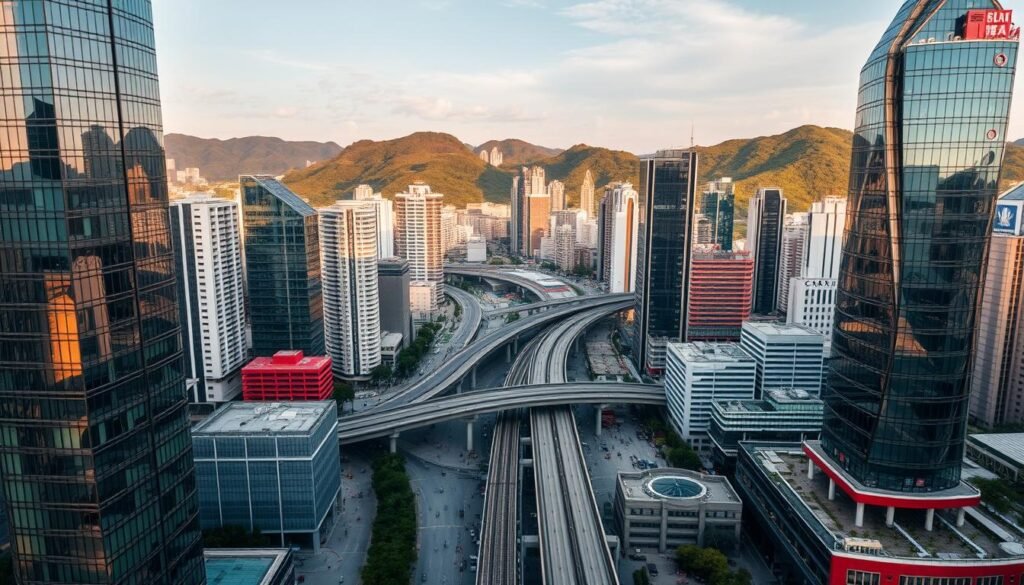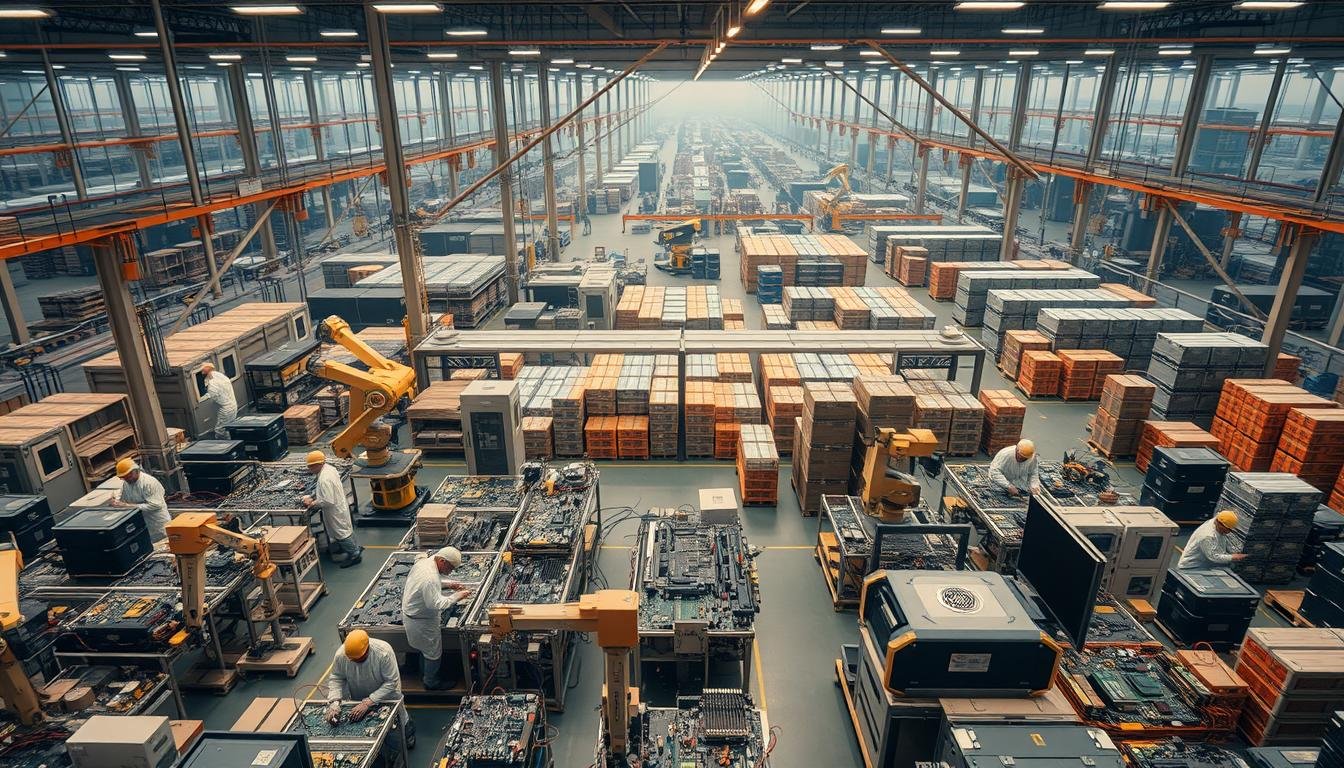Imagine cutting production lead times by 60% while slashing prototyping costs. A single region in southern China has become the backbone of global electronics innovation, yet many companies still operate through fragmented, slow-moving supply chains. This disconnect creates costly delays in an industry where time-to-market determines profitability.
With a $363 billion economy and 12 million residents, this urban powerhouse hosts over 10,000 electronics suppliers within a 50-mile radius. That’s more component vendors than Silicon Valley has tech startups. Businesses here can source resistors, microchips, and custom PCBAs within hours—not weeks.
The secret lies in clustered expertise. Designers collaborate with manufacturers on-site. Logistics teams ship prototypes to Tokyo or Singapore before lunch. Local suppliers provide real-time feedback during product testing cycles. This tight-knit network turns concepts into market-ready devices faster than traditional models allow.
Key Takeaways
- Shenzhen’s $363 billion economy supports immediate access to 90% of electronics components
- Lead times shrink by 40-70% compared to distributed supply chains
- 20-minute rail links to Hong Kong enable same-day international shipments
- Integrated R&D and production teams accelerate design iterations
- Local market insights reduce inventory waste by 35% annually
Geography shapes outcomes in electronics manufacturing. While other regions specialize in isolated aspects of production, this city combines every operational element into one hyper-efficient zone. The results? Businesses using this hub report 28% faster product launches and 19% higher profit margins than competitors relying on global suppliers.
Shenzhen’s Strategic Location and Global Connectivity
Positioning defines success in global electronics manufacturing. Our partners achieve same-day supply chain decisions through strategic regional placement. “The key to success lies in our location,” notes Jonell Wang, Tax Manager at Grant Thornton China. “We bridge Hong Kong’s global networks with mainland China’s production power.”
Access to Hong Kong and Mainland China
A 20-minute high-speed rail ride connects manufacturing hubs to Hong Kong’s financial district. This proximity lets teams approve prototypes before lunch and ship revised samples by afternoon. Companies maintain dual offices: one for international deals in Hong Kong, another for factory oversight across the border.
Shanghai sits just over 2 flight hours north. Tokyo and Singapore fall within a 4-hour radius. This concentrated access transforms how businesses operate. Production managers troubleshoot issues in person, while executives secure funding through Hong Kong banks – all within a single workday.
Geographic and Time-Zone Advantages
China Standard Time (GMT+8) aligns with 60% of Asia’s key electronics markets. Real-time coordination eliminates communication delays plaguing transcontinental teams. When Los Angeles offices close, Shenzhen engineers already implement next-day revisions.
Major Asian cities cluster within 4 flight hours. Kuala Lumpur? 240 minutes. Beijing? Under 3.5 hours. This compact network enables physical meetings without jet lag. Component buyers visit 12 suppliers daily – impossible in fragmented supply chains.
We leverage this unique positioning to slash decision cycles. Airfreight reaches Tokyo before sunrise. Customs brokers work overlapping shifts. Every geographic advantage converts directly to competitive edge.
Why Proximity to the Component Market Matters: The Shenzhen Advantage
Four decades of targeted development have forged Shenzhen into an electronics juggernaut. This transformation began when national leaders designated the area as China’s inaugural special economic zone in 1980. The strategic move unleashed market-oriented reforms that reshaped global supply chains.
Catalyst for Economic Transformation
The special economic zone framework revolutionized business operations through three key mechanisms:
- Customs duty exemptions for manufacturing imports
- Streamlined foreign investment approvals
- Tax incentives for technology-focused enterprises
These policies attracted multinational corporations while nurturing domestic innovators. Over 40 years, the city evolved from farmland to hosting 14,000 tech firms. Infrastructure projects like the Shekou Industrial Zone became blueprints for modern manufacturing clusters.
Talent-Driven Technological Leadership
Shenzhen’s workforce embodies adaptability. Nearly 70% of residents are under 35 – digital natives raised during China’s tech boom. The local government sustains this edge through:
- STEM-focused university partnerships
- Subsidized R&D facilities for startups
- Cross-training programs with global tech leaders
This ecosystem produces engineers who speak both component specifications and market needs. Teams routinely deliver design revisions within 48 hours – a responsiveness born from continuous skill development.
Young professionals flock here for what industry insiders call “the Shenzhen acceleration.” Recent graduates lead PCB layout teams. Factory managers hold advanced robotics certifications. This concentration of motivated people creates a problem-solving velocity unmatched in traditional manufacturing hubs.
Dynamic Component Markets: The Huaqiangbei Phenomenon

Global procurement teams know this truth: Component availability determines manufacturing velocity. At the heart of Shenzhen’s ecosystem lies Huaqiangbei – a 70-million-square-foot labyrinth where market forces operate at hyperspeed. What began as one store in 1988 now hosts 20+ specialized malls, forming Earth’s most concentrated electronics sourcing hub.
The Evolution of Huaqiangbei as an Electronics Hub
Three decades transformed this district into a living blueprint for component market development. Early vendors sold basic resistors and capacitors. Today, entire buildings specialize in AI chips or drone controllers. This evolution mirrors global tech trends – when 5G emerged, dedicated 5G component floors appeared within months.
Over 130,000 professionals work here daily. Young engineers troubleshoot circuit designs beside veteran suppliers. Startups refine prototypes using parts bought minutes earlier. This environment turns theoretical concepts into shippable products faster than any digital marketplace.
Market Scale, Product Variety, and Global Sourcing
Huaqiangbei’s annual 20-billion-CNY turnover stems from unmatched density. Buyers from the United States and North America source IoT sensors alongside Turkish drone manufacturers. Inventory depth astounds first-time visitors: One aisle stocks 57 capacitor variants; another offers same-day custom PCB etching.
The market’s structure enables strategic flexibility. Companies secure 10,000-unit bulk orders while testing new designs with retail-purchased components. Real-time price comparisons happen through casual conversations between stalls – intelligence that normally requires weeks of supplier negotiations.
This concentration creates ripple effects across global manufacturing networks. When automotive chip shortages hit, Huaqiangbei became the crisis control center. Suppliers rerouted components from consumer electronics lines within 72 hours – a feat impossible in fragmented markets.
Investment and Innovation in Shenzhen’s High-Tech Landscape

Global tech leadership now demands more than software brilliance—it requires seamless integration with manufacturing ecosystems. Shenzhen’s edge over rival cities like Shanghai emerges from its unique fusion of corporate R&D power and startup incubation infrastructure. Industry titans including Huawei and Tencent anchor a dynamic innovation ecosystem, while specialized industrial parks accelerate hardware breakthroughs.
R&D Support and the Role of Industry Giants
Tech parks like Nanshan District host over 14,000 firms spanning AI development to drone design. Tencent’s headquarters doubles as a startup accelerator, offering shared labs and mentorship programs. Government-backed grants cover up to 40% of prototyping costs for emerging technology firms, creating a launchpad for scalable innovations.
We’ve observed cross-industry collaboration that’s rare elsewhere. ZTE engineers consult with medical device startups on 5G integration. DJI shares manufacturing insights with robotics ventures. This synergy turns theoretical research into market-ready solutions 58% faster than in fragmented tech hubs.
Comparisons with Silicon Valley and Western Cities
While Silicon Valley excels in software, Shenzhen dominates physical product innovation. The city’s 55km Hong Kong-Zhuhai-Macau Bridge mirrors Northern California’s network effects—but with factories instead of venture capital firms. Hardware teams here iterate designs using same-day component access, a capability absent in most Western cities.
Key differentiators include:
- Integrated manufacturing clusters surrounding R&D centers
- Government policies prioritizing hardware startups
- Component markets within 30 minutes of design studios
This ecosystem produces tangible results: Shenzhen-based Chinese tech firms file 3x more hardware patents annually than their Bay Area counterparts. The convergence of technology development and immediate production capacity creates a competitive moat that’s challenging to replicate.
Shenzhen as a Gateway to China and South-East Asia
Infrastructure redefines regional commerce when backed by coordinated economic planning. Shenzhen’s role as Asia’s premier business nexus stems from trading links strengthened through the Greater Bay Area initiative. This $1.6 trillion economic bloc connects 11 cities through high-speed rail, smart ports, and digital customs systems.
Transportation, Trade Links, and the Greater Bay Area
The 55-kilometer Hong Kong-Zhuhai-Macau Bridge exemplifies how bay area infrastructure creates multi-market access. Trucks cross between mainland China and Hong Kong in 30 minutes – faster than intra-city deliveries in most Western cities. This engineering marvel supports 50,000 daily vehicle movements, slashing cargo transit times across the Pearl River Delta.
| Economic Zone | Population | GDP (USD) | Key Industries |
|---|---|---|---|
| Greater Bay Area | 72 million | $1.9 trillion | Electronics, Finance, Logistics |
| San Francisco Bay Area | 7.8 million | $800 billion | Tech, Software, Venture Capital |
| Tokyo Bay Area | 37 million | $1.7 trillion | Automotive, Robotics, Banking |
Companies achieve same-day distribution to three markets: mainland China through Shenzhen ports, Hong Kong via the bridge, and South-East Asia through Shenzhen Bao’an International Airport. Over 120 direct flights weekly connect to Jakarta, Bangkok, and Singapore – critical routes for time-sensitive electronics shipments.
This network makes ideal conditions for scaling regional operations. Manufacturers source components from Dongguan factories at 8 AM, assemble products in Shenzhen by noon, and reach Kuala Lumpur retailers within 24 hours. The greater bay area integration reduces border delays by 65% compared to traditional cross-country logistics.
Business Incentives, Infrastructure, and Government Support
Strategic policy frameworks transform business landscapes when paired with cutting-edge infrastructure. Shenzhen’s status as one of China’s original SEZs fuels its pro-business ecosystem. “The incentives here create a launchpad for scaling operations,” notes Jonell Wang, referencing the city’s 15% corporate tax rate for foreign investors – half the national standard.
Accelerating Growth Through Financial Innovation
The Qianhai zone reshapes regional economics with unmatched advantages. Qualified firms pay 10% less tax than Shanghai-based peers. Tech startups receive up to $3 million in relocation subsidies, while logistics companies secure $1.5 million capital injections. These policies explain why Shenzhen’s evolving economic profile attracts 40% of China’s venture capital deals.
Operational Excellence Through Smart Systems
Modern infrastructure turns geographical advantages into daily profits. Bao’an International Airport processes 80% of South-East Asian cargo within 4 hours. Automated ports clear customs using AI-driven documentation systems. We’ve seen clients cut inventory costs by 22% through real-time supply chain tracking across the Greater Bay Area.
Foreign talent gains equally robust support – income tax caps at 15% for specialists. This dual focus on human capital and logistics efficiency makes the city a springboard for global hardware ventures. Companies leveraging these systems report 31% faster regional expansion compared to traditional Asian hubs.
FAQ
How does Shenzhen’s proximity to Hong Kong benefit electronics manufacturers?
What makes Shenzhen’s workforce uniquely competitive for tech innovation?
Why is Huaqiangbei Electronics Market critical for hardware startups?
How does Shenzhen’s R&D environment compare to Silicon Valley?
What transportation advantages support Shenzhen’s role in the Greater Bay Area?
How does Qianhai’s special economic zone benefit foreign investors?
Can Shenzhen’s component markets replace traditional distributor relationships?
About The Author
Elena Tang
Hi, I’m Elena Tang, founder of ESPCBA. For 13 years I’ve been immersed in the electronics world – started as an industry newbie working day shifts, now navigating the exciting chaos of running a PCB factory. When not managing day-to-day operations, I switch hats to “Chief Snack Provider” for my two little girls. Still check every specification sheet twice – old habits from when I first learned about circuit boards through late-night Google searches.
